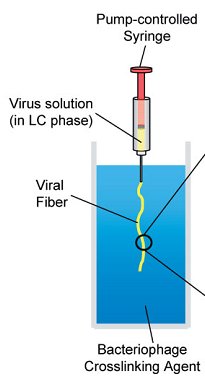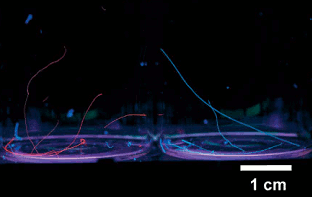Fiber Made Out of Viruses?

With advancing nanotechnology, people often need to make custom fibers with special properties such as conducting electricity or sticking to certain substances. These fibers can be created using fancy synthetic materials and complicated chemistry. Or as Chiang and coathors suggest you could try to make fibers out of viruses after modifying the viral DNA to perform the desired task. I’m not sure this is actually all that much easier but it sure seems cooler and perhaps (hopefully) as things develop it actually will be more cost effective.


To put their money where their hypothesis was, Chiang et al. set out to make custom fibers from a virus called M13. The M13 virus is a bacteriophage (a virus that infects bacteria) that looks like a string (instead of the little lunar lander shape in all the textbook virus illustrations). Interestingly, it’s made up of only a handful of proteins; a couple on one end, a couple on the other end, and then a bunch of repeats of a single protien to make a long tube covering it’s DNA. To make virus fiber, the research take a concentrated solution of viruses and squirt it from a syringe into a bath of glutaraldehyde. The glutaraldehyde forms links between neighboring viruses to form a continuous fiber. The researchers found they could adjust the glutaraldehyde concentration, the rate of syringe ejection and how much pull was applied to the fiber to make virus fibers with differing characteristics. They even took the fibers they made and tested them in fiber strength tests. It turns out virus fibers are about as strong as nylon.
To really highlight the benefits of viruses, they also used genetically modified forms of M13 whose DNA coded for proteins that bond well with certain substances. By modifying the highly repeated protein forming the viral tube, they can make viruses (called E4) that really stick to quantum dots. They then used this virus to make fiber containing high concentrations of quantum dots (good for optical sensors [or whatever uses people come up with for quantum dots]). To really show off, they also found a modified M13 virus (p8#9) that showed high affinity to gold (much like my fiancee) and used it to make gold coated virus fibers (think microscopic wires).
When I saw that picture of viral fibers, I was pretty amazed. I’ve always thought of viruses as invisible and problematic (not helped by the fact that I’m fighting off a cold right now) but here these researchers are making real world useful things out of them. And they can manipulate the genetics of the virus to add custom special properties. It’s really cool to see how biotechnology is progressing.
Reference
Chiang, C., Mello, C., Gu, J., Silva, E., Van Vliet, K., Belcher, A. (2007). Weaving Genetically Engineered Functionality into Mechanically Robust Virus Fibers. Advanced Materials, 19(6), 826-832. DOI: 10.1002/adma.200602262